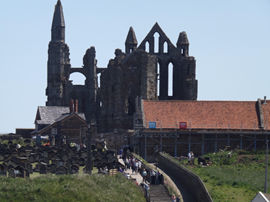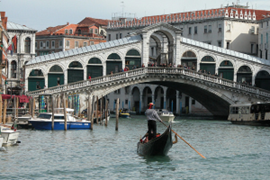Conservation in Germany
Michael Asselmeyer suggests that whilst at first glance, the organisation of conservation in Germany may seem confusing, almost exotic to a British observer, the systems in both countries are not entirely different.

|
| Frauenkirche, Dresden, 1726–1743, by George Bähr, destroyed 1945, rebuilt 1994-2005 using surviving masonry (Photo: Lupus in Saxonia, Wikimedia Commons). |
In 1996, during an internship at the department for the supervision of Museum Island at the Federal Construction Board Berlin, I was involved with the on-site recording of the partially destroyed Neues Museum and witnessed the ongoing discussion in the recently merged civil service units about the treatment of heritage in the reunited capital. Before its reincarnation in the federal governance system, that department had already been a unit of the communist system, from where almost all of my colleagues originated. It was a unique opportunity to gain insights into different standards of conservation philosophy and politics.
Apparently the government of the former German Democratic Republic had planned to complete the rebuilding of the war-damaged ensemble of the five museums, a national treasure and Berlin’s equivalent of Albertopolis or the Louvre, in time for the celebration of the anticipated 50th anniversary of the GDR in 1999. Construction professionals had been made available in the 1980s, but neither the workforce nor the officials had excelled in the application of international heritage and conservation standards.
Faced with the approaching deadline, the officials back then had favoured a combination of restoration and reconstruction, and had sacrificed some still-standing parts of the ruin such as the Egyptian Courtyard and the north elevation of the Neues Museum, in order to rebuild them on the basis of excellent documentation. Thought had even been given to repainting the completely lost 75 metres of historiographic wall paintings by the 19th-century artist Kaulbach in the main staircase on the basis of the surviving studies. Evidently the ‘idea’ of the monument had enjoyed just as much appreciation as the fabric itself, whereas the idea of minimal intervention had not.
While one may understand the rationale that the removal of a damaged wall would almost certainly simplify the necessary refitting of a concrete slab under the remains of the structure, and that it would be possible to reconstruct the wall on top of the new slab later on, such an approach would be inconceivable for those following the teachings of William Morris. In the end, the ruinous north wall of the Neues Museum was not the only wall in Berlin to be torn down in the 1980s, and after the regime change in 1989/1990 the originally planned reconstruction by 1999 became obsolete. Instead, the museums launched an international competition for the rebuilding of the Neues Museum, which ultimately led to the commissioning, in 1997, of David Chipperfield with Julian Harrap.
I joined the team as Harrap’s site architect while SPAB and Unesco principles were taking hold of Museum Island. The Federal Construction Board (the client), the Museums of the Prussian Cultural Heritage Foundation (the users) and the Berlin Monument Office (the conservation authority) worked hand in hand with us on the mammoth task of completing the classicist ‘Athens’ on the island within the River Spree, and to prepare it for 21st-century cultural tourism.
It may come as a surprise to foreign observers that a project of such magnitude, national and international importance was steered in liaison with the Berlin Monument Office (Landesdenkmalamt Berlin) rather than the federal German authority. But conservation in Germany is not a federal issue. Although the 1998-created office of a federal commissioner for culture and media (Beauftragter der Bundesregierung für Kultur und Medien) provides support and funding for institutions and projects of national importance, the federal state has no constitutional competence in cultural affairs. Instead, each of the 16 German states that form the Federal Republic of Germany is sovereign in matters of culture, including heritage and conservation.
This seems to be the obvious consequence of 12 years of centralist governance under the Nazi regime, when the very terms ‘German culture’ and ‘German heritage’ were being permanently stained. But cultural federalism in Germany goes back much further. From 1815 until 1866/1871 the various predecessors of the current 16 German states were sovereign countries. It was during this period that conservation evolved, from being a patriotic reaction to the years of French occupation under Napoleon until it manifested itself in the form of a government department or agency. Nine of the states of the Federal Republic evolved from provinces of the former Kingdom of Prussia, where the institutionalisation of conservation started with Schinkel’s Memorandum in 1815. In other German territories, state intervention in heritage matters started independently (in Württemberg as early as 1670), and has therefore always been associated with the administration of the member state rather than at federal level.
Each state has its own law concerning the protection of monuments. Although they align in principle, there are subtle differences. For example, there are 18 rather than 16 state offices for monument care (Landesämter für Denkmalpflege): one in each of the 16 German states (Länder), but two in the most populous state of Nordrhein- Westfalen (one for the Region of Rheinland and one for the Region of Westfalen-Lippe), and two in the state of Schleswig-Holstein (one for the once sovereign Hanseatic City of Lübeck, whose old town is a world heritage site, and one for the remaining territory). As with conservation, governance of archaeology takes place at member state level, except in Cologne where the Region of Rheinland has delegated archaeology to the city’s Römisch-Germanisches Museum (founded in 1809).
The 18 heads of the state offices for monument care form a non-statutory association (Vereinigung der Landesdenkmalpfleger, VDL), a standing committee that contributes to working groups and strives towards a level of consistency in the implementation of policy. Together, the cultural interests of the 16 states are represented at the standing conference of the secretaries for culture (Kultusministerkonferenz, KMK). Another organisation at federal level, the German National Committee for Monument Protection in Bonn (Deutsches Nationalkommitee für Denkmalschutz, DNK, founded in 1973), acts as the national interface for all organisations involved in conservation, whether statutory or non-statutory, secular or ecclesiastical, professional or voluntary.
Administratively, all conservation in Germany is divided into the two realms of monument protection and monument care, both of which are sometimes located within the same authority.
- Monument protection (Denkmalschutz) refers to listed building consent and has therefore been integrated into the hierarchy of each of the 16 states (normally two- or three-tier: local conservation authority as first port of call at the lower level, state executive at the highest level, complemented in larger states by an intermediate level authority dealing with appeals).
- Offices for monument care (Denkmalpflege) are government agencies in each of the 16 states, staffed with experts who advise owners and authorities on conservation.
In Germany, with over a million listed monuments representing 2,000 years of architecture, the range of approaches to conservation can be as diverse as the organisation of conservation is complex. The belated reunion of the divided Germany in 1990 has led to debates and projects of a nature and size not seen since the post-war years. As in other European countries, the rebuilding of bombed cities after the second world war had seen large areas of ruins and rubble being replaced by modernist settlements laid out in the spirit of the Athens Charter. A more heritage-friendly approach to urban development did not gain ground until the 1970s, but some towns and cities had chosen different ways.
Münster, the former capital of the Prussian province of Westphalia, for example, had started rebuilding its centre in 1945. In the 1990s, such an approach seemed anachronistic to some, so it was the subject of endless discussions about German and East German identity as to whether the removal of post-war structures and the rebuilding of the centre of Dresden or of the royal palace in Berlin’s city were justified after an interval of more than 50 years. The rebuilding of the Frauenkirche in Dresden by means of re-using salvaged masonry from the ruin in its original position has been widely acclaimed, but the additional reconstruction of the surrounding neighbourhood by private investors has attracted consent as well as criticism.
At first glance, the organisation of conservation in Germany may seem confusing, almost exotic to a British observer, but the systems in both countries are not entirely different. Think of the UK as the equivalent of the Federal Republic and you may find that its constituents England, Wales, Scotland and Northern Ireland have their Historic England, Cadw, Historic Environment Scotland, Historic Environment Division, Northern Ireland, just as each of the German states has its own conservation agency. Just as the heads of conservation of each German state collaborate at the meetings of the VDL, so their British counterparts collaborate at the Home Countries Heritage Agencies Chief Executive (HACE) meetings.
The efficient work carried out by professionals in private practice as well as by government agencies and departments, charged with the implementation of regional, national, European and international policy, clearly demonstrates one thing: that it is possible to be, at the same time, Saxon, German, European and passionate about heritage just as it is possible to be, at the same time, English, British, European and passionate about heritage.
This article originally appeared in IHBC's Context 157 (Page 18), published in November 2018. It was written by Michael Asselmeyer, a chartered architect and historian in Birkenhead, who has been a scholar in Bologna, a research assistant in Münster and Berlin, a conservation architect and head of conservation and design in London, and a university lecturer in Dundee and Preston.
--Institute of Historic Building Conservation
Related articles on Designing Buildings Wiki
- Brexit and UK research into cultural heritage.
- Conservation.
- Conserving Europeanness.
- Great Yarmouth Preservation Trust.
- Harmonising heritage in the Nordic countries.
- Heritage and Brexit.
- Heritage.
- Historic building.
- IHBC articles.
- International heritage.
- Post-war new towns in Germany.
- Post-war rebuilding.
- Socialist realism in a post-war Czechoslovak new town.
- The Institute of Historic Building Conservation.
- Visby as a historic urban landscape.
IHBC NewsBlog
National Trust for Canada’s Review of 2024
Great Saves & Worst Losses Highlighted
IHBC's SelfStarter Website Undergoes Refresh
New updates and resources for emerging conservation professionals.
‘Behind the Scenes’ podcast on St. Pauls Cathedral Published
Experience the inside track on one of the world’s best known places of worship and visitor attractions.
National Audit Office (NAO) says Government building maintenance backlog is at least £49 billion
The public spending watchdog will need to consider the best way to manage its assets to bring property condition to a satisfactory level.
IHBC Publishes C182 focused on Heating and Ventilation
The latest issue of Context explores sustainable heating for listed buildings and more.
Notre-Dame Cathedral of Paris reopening: 7-8 December
The reopening is in time for Christmas 2025.
Stirling Prize-winning Salford building to be demolished
The Centenary Building will be bulldozed as part of the wider £2.5bn Crescent regeneration project
Volunteers work to transform 100-year-old ‘hidden’ building into bothy
The building, named Druimnashallag, is located southeast of Oban.
The new ‘Arches for HERs’ Demo site, from the Getty Conservation Institute via HE
It shows how organisations responsible for historic environment records (HER) management can benefit from its powerful features.
ICOMOS-CIF 2024 Symposium celebrates 40th anniversary in Venice
It aims to critically review current practices and theories of conservation of built heritage around the world, and more.

















Comments
The Dresden Frauenkirche was not Conservation, it was replication. So why the photo?